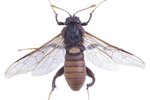
Cecropia moths (Halophora cecropia) belong to the Lepidoptera family Saturniidae. This family contains royal moths and giant silk moths. Almost all species are large; the cecropia is the largest moth in North America. Their lifespan is a perfect circle lasting approximately one year; the female lays her eggs and dies shortly after. The best time to spot these winged creatures is during late spring and early summer when the adults are active.
Description
The conspicuous cecropia adults have brilliantly patterned wings and bodies. Their colors and patterns aside, their large size makes them favorites of collectors and nature enthusiasts. Reaching approximately 5 to 6 inches, the cecropia is the largest silkmoth in the United States. Their wings have a frosted, blackish-reddish-brown color with cream, red and black accents in the form of stripes and spots. The thick larvae are equally impressive, reaching mature lengths of approximately 4 inches. Bright blue and yellow tubercles covered in black spines adorn their pale-to-lime green bodies.
Adult Stage
Although they only live five or six days, the adults capture the eye of anyone lucky enough to see one at night. The adults hatch from their cocoon on mornings in spring -- May through June throughout much of their range. Their first day as winged adults is spent clinging to a branch as they allow their bodies to dry and quickly pump their wings to get blood flowing to them and lengthen them. The females remain perched due to being egg-laden, and send out a pheromone to attract males just before dawn. After mating, the male will hide during the day and continue finding females just before dawn. The female, however, will almost immediately begin laying eggs in small clutches. She diligently spreads out the small clutches of eggs to help minimize the risk of competition among larvae. Once she's done, she'll have laid about 350 eggs.
Larvae
The larvae hatch from the cream-colored eggs as 1/4-inch black caterpillars. The larval stage typically has five instars -- periods of postembryonic growth -- lasting one to two weeks each; the larval stage can last one to two months. During the second instar, the black larvae begin developing colorful bodies, although the colors can vary. The larvae display their bold color patterns during the last three instars. The first instar is when the caterpillars feed voraciously, although they feed throughout all phases. In late summer, the large, green caterpillars begin constructing their cocoon, a small, brownish-gray sac they attach to a twig. The caterpillar will begin pupation in this cocoon and overwinter in this protective case.
General Information
In general, cecropia larvae prefer deciduous trees as their host plants. Fruit trees are a favorite of these brightly colored caterpillars; apple, cherry and plums are all preferred host plants. Other favorites include birch, black cherry and white oak. Their habitats vary throughout their range, from deeply wooded areas to suburban landscapes.
References
- University of Kentucky: Saturniid Moths
- Cornell Cooperative Extension of Oneida County: Cecropia Moth
- University of Illinois: Species Spotlight: Cecropia Moth
- University of Florida IFAS Extension: Cecropia Moth, Cecropia Silk Moth, Robin Moth, Hyalophora Cecropia Linnaeus
- Iowa State University: Cecropia Moth
Photo Credits
-
Brand X Pictures/Brand X Pictures/Getty Images
Writer Bio
With a professional background in gardening, landscapes, pests and natural ecosystems, Jasey Kelly has been sharing her knowledge through writing since 2009 and has served as an expert writer in these fields. Kelly's background also includes childcare, and animal rescue and care.



